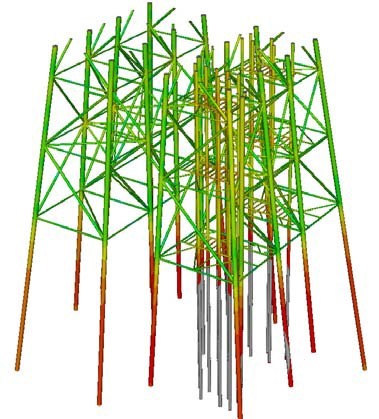 An offshore jacket complex consisting of five platforms is protected by a conventional sacrificial anode cathodic protection (CP) system. The jacket complex is located in the North Sea at a water depth of 35 m and includes a subsea valve station and eight subsea pipelines. The platforms date from 1967 to 1975 except for one recently installed structure. The jacket structures are all bridge linked and electrically interconnected. Recent CP potential measurements and anode inspections of the existing platforms indicated that a significant amount of anodes have a remaining lifetime of less than 20 years, and extending the end-of-service life would require a significant retrofit effort in the near future. Due to the high cost and safety risks during the installation of a retrofit CP system with sacrificial anodes, an alternative impressed current CP (ICCP) anode sled system was investigated. Remote ICCP anode sleds are relatively easy to install, but designing such a CP system is more challenging. Correct positioning of the sleds is critical for obtaining proper protection and avoiding overprotection. Using a three-dimensional computer-aided design (CAD) model of the offshore jacket complex and computational modeling, a graphical representation of the IR-free potentials on the structure was developed so the feasibility of the conceptual retrofit ICCP system design could be validated and optimized. First the existing CP status of the complex was simulated using the condition of the sacrificial anodes as observed during the latest survey. Second, an ICCP system was modeled and various anode sled positions were investigated until an optimal design was obtained. The remaining life of the existing anodes was calculated to keep the number of anode sleds to a minimum. Through modeling, the CP effectiveness of the combined system was validated and a cost-effective solution was proposed. The simulation results are discussed in CORROSION 2015 paper no. 6012, “ICCP Retrofit Challenges for an Offshore Jacket Complex,” by C. Baeté.
An offshore jacket complex consisting of five platforms is protected by a conventional sacrificial anode cathodic protection (CP) system. The jacket complex is located in the North Sea at a water depth of 35 m and includes a subsea valve station and eight subsea pipelines. The platforms date from 1967 to 1975 except for one recently installed structure. The jacket structures are all bridge linked and electrically interconnected. Recent CP potential measurements and anode inspections of the existing platforms indicated that a significant amount of anodes have a remaining lifetime of less than 20 years, and extending the end-of-service life would require a significant retrofit effort in the near future. Due to the high cost and safety risks during the installation of a retrofit CP system with sacrificial anodes, an alternative impressed current CP (ICCP) anode sled system was investigated. Remote ICCP anode sleds are relatively easy to install, but designing such a CP system is more challenging. Correct positioning of the sleds is critical for obtaining proper protection and avoiding overprotection. Using a three-dimensional computer-aided design (CAD) model of the offshore jacket complex and computational modeling, a graphical representation of the IR-free potentials on the structure was developed so the feasibility of the conceptual retrofit ICCP system design could be validated and optimized. First the existing CP status of the complex was simulated using the condition of the sacrificial anodes as observed during the latest survey. Second, an ICCP system was modeled and various anode sled positions were investigated until an optimal design was obtained. The remaining life of the existing anodes was calculated to keep the number of anode sleds to a minimum. Through modeling, the CP effectiveness of the combined system was validated and a cost-effective solution was proposed. The simulation results are discussed in CORROSION 2015 paper no. 6012, “ICCP Retrofit Challenges for an Offshore Jacket Complex,” by C. Baeté.